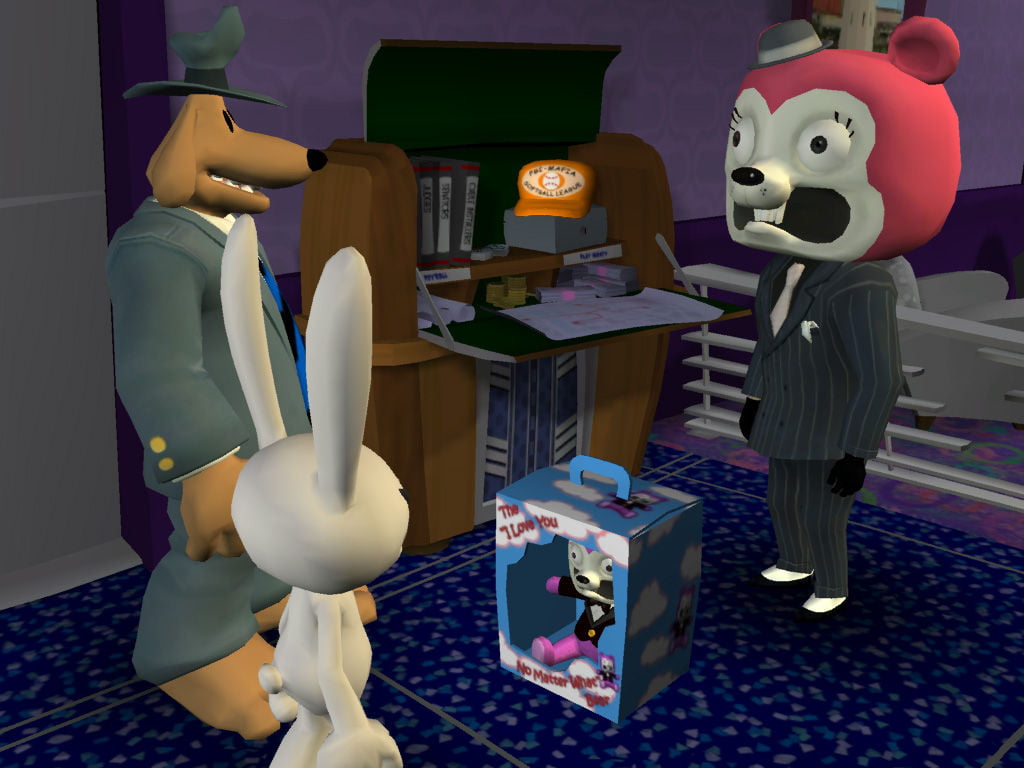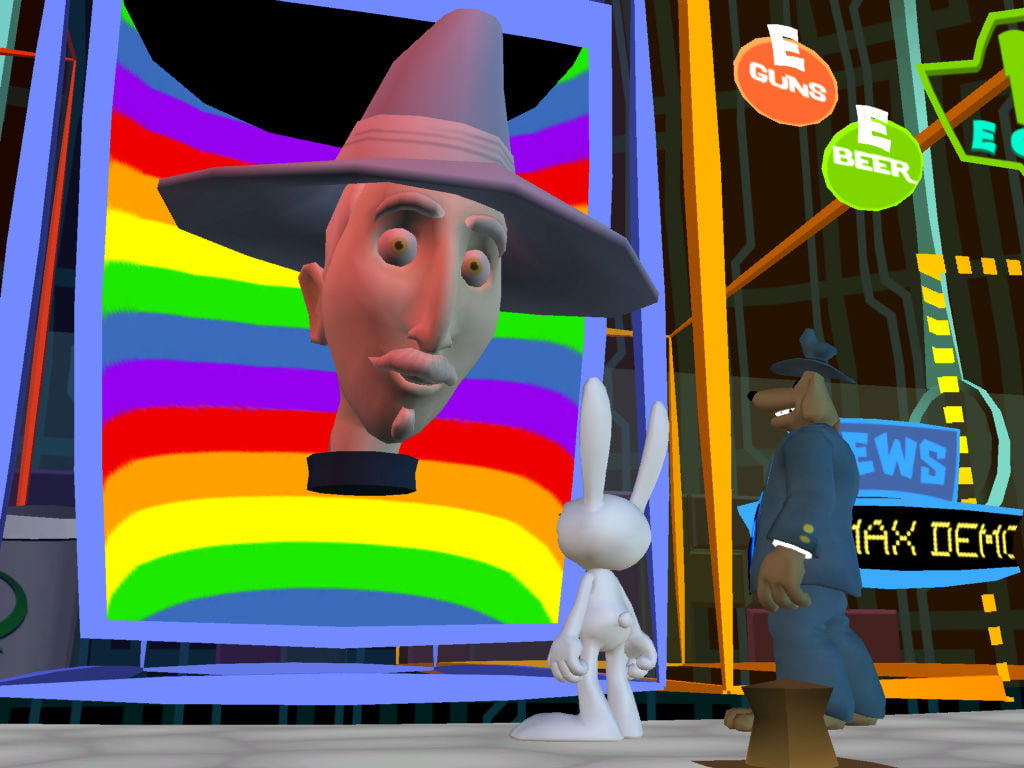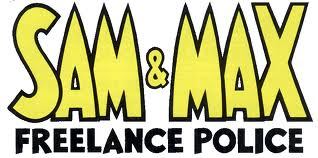I wanted to write about this game three weeks ago – but I felt I had to get perspective. I felt I had to really get into the roots of what I actually thought, what I actually felt about this game and why I wasn’t liking it. I wanted to resist the knee-jerk response of but it’s new, it’s not as good. I wanted, I really wanted, this small form delivery of adventure game content to be a good idea, and I wanted to hold it up, I hope, to people who might want to consume more of it, who might have been shy, as if The Walking Dead and The Wolf Among Us hadn’t already seized most critical attention and pulled eyes onto this form.
Still, I am a Sam & Max fan; I do love this franchise, such as it is. Or do I just love one particular game and a cartoon? Oh, these are the tangled spaces we find ourselves in as we indulge in fandom.
Ugh.
Still, let’s get it straight.
What Are You Getting?
If you buy the Sam and Max episodes, you’re getting a handful – well, a big handful – of short games that want to render a sort of episode of the cartoon series – I assume – in the model of a point-and-click adventure game, like the original game. They are, as point and click games go, tolerably fine. They’re acceptable. They work.
They’re just not very good, not captivating. They don’t have it in them to pull my attention, to make me want to keep going. I’m not left with a desire to explore or listen or laugh as I play the game – with its deliberately doughy interface, everything feels as if I have to wait an extra half-second to try things.
Still, that’s more of a complaint about the interface than anything else, I guess. The narrative-
Ugh, the narrative has problems too. Well, okay, there are puzzles in this game, which tend to pretty simply fit the model of finding the right silly object to interact with the right unreasonable demand – shaving cream letting you pass an audition as a rabid dog, for example – and there’s nothing too challenging in putting them together. Since the interface is a The Dig style two-button clicker, you can look at objects or ‘interact’ with objects and that’s usually all you get. This means that your experience is filtered through the characters-
Oh yeah, hang on, the characters are conveyed through fully voice-acted…
Augh, okay, that has problems too.

To put it in the simplest terms: Sam and Max episodes exist. They are not, as far as I can find, buggy, they are not blatantly horrible or outrightly racist though they draw on a space in Americana that’s at least a little disdainful of weird things and weird people, and chances are good with the way they go on sale on Steam, you probably own them already. Everything it does is very typical for doing what it does at the time it did it, and to a certain extent it feels like someone popping open point-and-click adventure games around 2005 and, assuming literally nothing had happened since 1994, just went about the process of making one in a 3d engine. It is a first draft, a competently made game that has the impossible task of following the lead of one of the greatest games of its genre ever made.
They are also a guide to how the original game did things excellently.
Okay, Now Here’s Why It Sucks
I don’t want to be one of those old-school purists, saying look at what the originals were like or these new things suck. I’m not that kind of person and also, I was an adult before I ever really appreciated how good Sam and Max Hit The Road was. What’s more, it’s not like there’s any chance of better Sam and Max coming. Still, my complaints with these episodes are so in-depth, so heavy that I found myself literally reaching for a textbook to dig up reference points for them.
In the Design of Everyday Things, by Don Norman, a Quite Good Book that’s Definitely Worth Reading (and lots of people will tell you that), Don Norman outlines two things good design wants to have: discoverability and feedback. Discoverability is that when you look at a thing, you should be able to tell by looking at it that it’s a thing you can interact with or that it reacts to your presence. In point-and-click adventure games there’s a ton of ways to do this, and the original Hit the Road used animation and art design to do it as well as an interface trick. The other thing is feedback – when you interact with a thing, it should give you some feedback about what it is you did or what you’re doing is accomplishing. These things are going to come up a lot, so let’s just bear ’em in mind.

In the Sam and Max episodes, the camera sucks. First-person and third-person camera games can direct the viewers’ camera to where they want to go or where they’re going to. These games are part of how 3d engines took over the world, since once you make the tools to construct a 3d world that’s primarily interacted with in combat or movement based ways, you can do a lot with them and they give a really nice feeling of being in the space. In a point-and-click adventure game, though, there’s a lot more of the game that’s about observing a space at a distance and, thanks to that distance, needing a character to provide you some meanignful scrutiny, some feedback about what you’re looking at and maybe give some indication of what you can use that thing for later.
In Sam and Max Hit the Road, the camera is almost always completely static; characters move around on screen, which can pan left and right, but never turns or curves. This is, yes, a technological limitation but it’s one the game uses to its advantage, making all the environment detailed and vivid and use art direction to pop the important elements of what you’re seeing out to get your attention. By using composition of a static image, they never have to reconcile moving a camera into a more appropriate spot to look at an object from a perfect angle, or reframing anything. Without the ability to reframe things, everything in Hit the Road has to be visible at a distance and that makes sure the viewer – or player in this case – can discover them. Then, the interface changes as you move your mouse over them, letting you interact with them, or try to interact with them – and that interface let you pick what form your interaction would take. You could try talking to things that wouldn’t talk, and then the game wouldn’t let you and that was that – but you had that feedback, that indication that you can do something, but not that.
The camera reframing also brings with it a style of dialogue that doesn’t suit the comedy style all that well. Characters converse in shot-reverse shot, where a character starts to talk and the camera moves to entirely focus on the, often with other characters completely missing from the frame, without much attention paid to the size of their heads or the distance between them. Shot-reverse shot is a classic cinema style, so much so it’s considered basic, but even that basic form in the episodes goes wrong because they’re timed badly. Every character hesitates after their line, at least a bit, meaning that comedic dialogue isn’t snappy and clever, it’s not reactive and responsive, and is instead full of these unnatural almost laugh-track-like pauses.
The original games didn’t have a lot of room for interjection – there are only a few really noteworthy points where the voice engine actually goes for an interruption, meaning most dialogue is written to be short, discrete phrases that have their joke or setup in them in the entirety. This pushes the dialogue towards short-form absurdity, where things don’t get heavily explained, because any given exchange of dialogue has to be made up of a series of pauses. The most natural pause is between two people talking, so most dialogue in Hit the Road is a back-and-forth style, rather than one character doing a monologue.
What keeps Hit the Road working then, is that they refined that timing down to a point. In Episodes, the pauses are simply too long – and there doesn’t seem to be any way to change that. They just are too long and, well, that’s what’s going to happen. It’s the kind of thing you’d notice if you played the two side by side – why is our dialogue flat and theirs so snappy? – but instead, they just kind of exhale out into the world.

A thing I want to underscore here is that at no point am I trying to say This game isn’t Sam and Maxy. The Episodes are not failures because they fail to express the way Sam and Max worked, or that the characters are behaving in ‘wrong’ ways. There are three sources to me, of other Sam and Max content – comics by Steve Purcell, the TV series, and the previous game.
While I hold this game up to the standards of the first game, it is important to recognise that the other game is just a better game, that the tools and design of Hit the Road are superior implementations, and, thanks to whatever reasons this game has for being a 2006-ass game that seemed to not notice developments and evolutions in point-and-click adventure puzzle games in the intervening times.
The sense of humour in Hit The Road is a road trip of Americana, of things that, themselves, are references to non-specific things; you don’t go to Stuckeys, you go to Snuckeys. You don’t go to Neverland or Graceland, you go to Bumpusville. Part of the charm, to me, of Hit the Road is that it’s not name-dropping the things that exist in the world as much as it is making pastiche ripoffs of all of them, the photocopy memory of a child in the twisted funhouse mirror of Sam and Max sensibilities. The Episodes instead make name-dropping jokes about Dr Phil and Oprah and – just stuff that doesn’t have the same charm.
The most interesting thing to me here is a comparison between the arc of technology, of game development tools. Consider that Sam and Max Hit The Road came at a time when Lucasarts had just made Day of the Tentacle and were rising in public consciousness; there was no pre-existing Sam and Maxness they had to live up to, no nod-wink fanbase they had to appeal to. Things like the lessons of using contrast and pixel art and ways to do a game like that excellently were all built up and Sam and Max Hit The Road got to be a masterpiece, a peak of the tools they had to create.
The Episodes are a lot more rudimentary. They’re amateurish. They’re not failures per se. But they are mediocre games that, by dint of their characters and storytelling, want to stand alongside one of the best games in its genre ever made. And the worst thing is even if they weren’t held to that standard they’d still be pretty mediocre games. They are content to merely exist.
How does this, you may wonder, relate to the Nuclear Throne, the game I just talked about in between these two? Because Nuclear Throne is a game that loves its subject matter. It loves its genre. It evolves and develops on what it has, but that also comes from knowing what it is, really, deep down. It knows what makes a shooter work and it knows the genre of media it’s drawing from. It’s not this, this unfocused slurry of half-remembered point-and-clickery that doesn’t know how to pull off the comedy aspect, doesn’t know how to handle its control scheme, doesn’t know how to be funny and doesn’t know what made the original Sam and Max a truly astounding classic.
Verdict
You can get Sam And Max Episodes on GOG, and Steam.
Verdict
Get it if:
- You’re a completionist
- You need a much simpler interface for puzzle games
- You’ve got a real nostalgia for that sort of mid-2000s, pre-Wadjet-Eye point-and-click 3d adventure game
Avoid it if:
- You’re bothered by choppy interfaces
- You’re bothered by choppy video
- You want more of the original game
